The alarm came too early at 3:30 a.m. By the light of our headlamps Benj and I quietly made coffee and breakfast inside our tent. While we were still cocooned in our sleeping bags to stay warm, Benj opened the frosty zipper and looked outside. Nothing but stars. We left our tent a few minutes before 5 a.m. but discovered our team members still had coffee in hand and camp booties on their feet. To stay warm, we went back inside and covered our legs with a sleeping bag and looked over the maps again for the day’s route.
The skies were deep blue, the snow glistening as we made the first mile in the flats, heading toward the initial two summits on our mission to become the first group to ski the 12 tallest peaks in the Swedish Arctic and make a movie about it. Not an hour into the day, we had already stopped several times to film. Though we had perfect weather, a violent storm was forecast to come in that evening and last for several days.
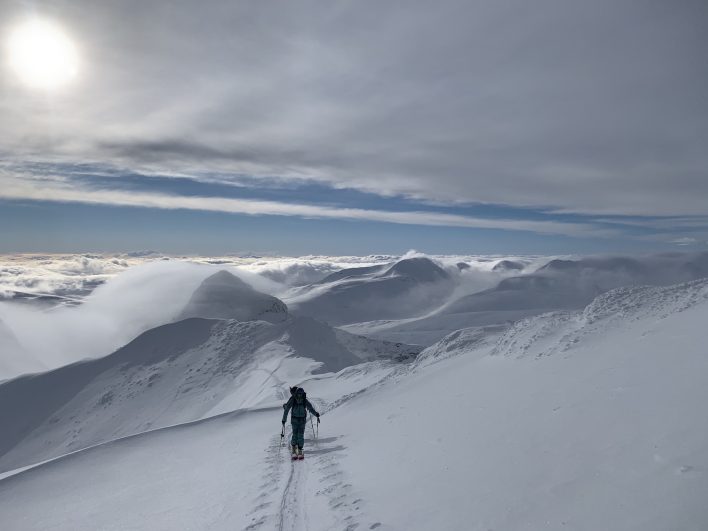
Benj and I urgently tried to share our message with the team: Either we moved faster, or we would not summit the first two peaks that day. With irritation, they agreed that we could film on our personal action body cameras and keep the pace moving forward.
Nearing the top of the first rise on our long approach, the big camera came out again and travel slowed. We had already lost more time climbing up sheets of ice divided by firm wind-packed wave formations to reach this point, and we had many unknowns ahead. I said again that we needed to keep moving. More pushback. “We are here to make a movie!” my friend Jackie Paaso agitatedly replied.
The challenges would continued to build throughout our 26 days in the field, and—though not for any reasons I’d anticipated—this project would become the most challenging expedition I’ve ever been a part of.
As an internationally certified mountain guide living and working in the French Alps, I spend my winters guiding skiers down steep, powdery couloirs and wide-open glaciers, while summers bring climbing alpine peaks, traversing through basins of cracked blue and gray ice, and scaling thin, rocky ridges to quiet summits. I do this to provide and share enduring moments and meaningfully earned smiles with my clients, to push their limits and teach them new skills while trying to create a seamless flow through distant heights. The work of keeping people safe in the mountains requires constant observation and assessment of terrain, snow conditions and weather, as well as matching our activities with my clients’ technical skills and managing time and surroundings, often in remote locations.
While I love my job, I relish taking extended breaks during the late spring and autumn to pursue personal mountain projects. In April 2021, Jackie and I had planned a ski expedition to the Alaska Range. Due to Covid-related border closures and denied park permits, we were forced to quickly devise a backup plan. To Jackie’s knowledge, no one had ever summited Sweden’s 12 highest peaks in one linkup. Along with wanting to climb and ski, we decided we would create a movie along the way. With a lot of hustled planning, the Arctic 12 project launched. The plan was to try and link the 12 peaks in Sweden above 2,000 meters, or roughly 6,560 feet, in one continuous push on a human-powered ski traverse, all above the Arctic Circle. With cross country skis on our feet for the long, flat traversing sections, we planned to pull sleds filled with our food, fuel, tents, downhill skis and technical equipment over 250 miles, climbing and skiing the peaks from our camps.
Our expedition team had a variety of backgrounds. My partner Benjamin “Benj” Ribeyre and I brought our skillset as IFMGA mountain guides based in La Grave, France, and Jackie and her husband, Reine Barkered, were American and Swedish Freeride World Tour athletes. The final member was Martin Olson, a Swedish cinematographer. Martin was the only one officially working, and the rest of us joined as mountain partners ready to see if together we could succeed in this goal. While some of us were acquainted, none of us knew everyone on the team before the project launched. This certainly was a risk, but our time window was running out and we had to make decisions quickly.
During the preparation week, our group experienced a stream of unfortunate events: a sewage flood in Jackie and Reine’s garage the day we needed to organize and pack, lodging complications because of Easter weekend, missing a sled, rushed planning and packing, and the team conversing in a mix of English, Swedish and French. These hardships, coupled with unusually dangerous avalanche conditions, left us all in need of a morale boost, but instead we were given a rough, slow start.
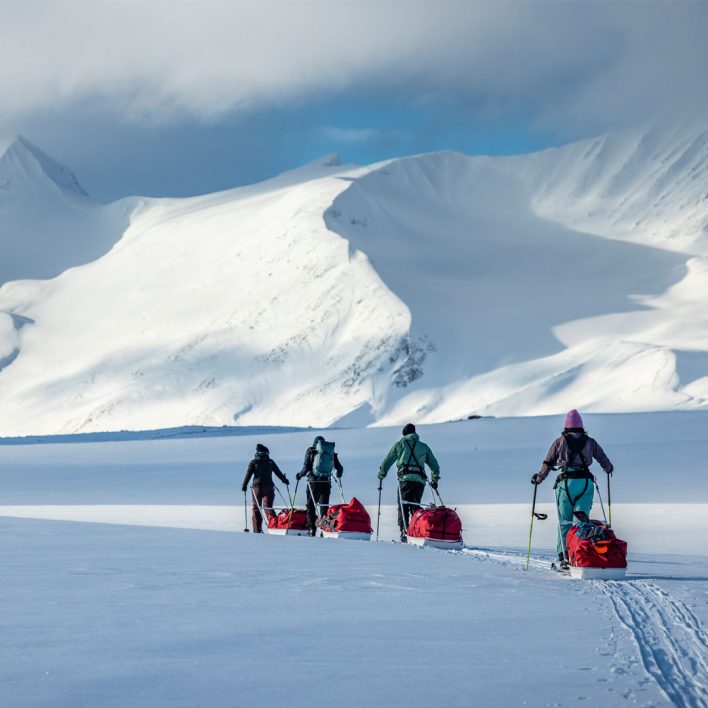
My sled tugged firmly on my waist harness as we climbed out of the parking lot and onto the snowmobile superhighway of the Kungsleden, filled with brake bumps and the stickiest snow of the entire trip. We had 595 pounds of gear divided between our five sleds. The wet snow’s resistance led to a pace of 2.5 miles in the first two hours.
The physical endurance requirements of traversing Sweden’s Arctic mountains and pulling all our equipment for the monthlong expedition quickly became a harsh reality. We wondered if we had overestimated our strength to haul these heavy sleds such a distance during those first several hours. Far from any signs of human travel, we climbed onto a plateau on the edge of Sarek National Park just as the clouds cleared in the darkening evening sky and the sleds finally began to glide as the snow cooled. The Arctic light shined, its multitude of grays and blues echoing on the endless white mountaintops, lightening both the sky and everyone’s mood.
Inside my dry, warm sleeping bag, I did a quick navigation and time plan for skiing the first two summits out and back from camp: 25 miles of travel and 6,500 feet of gain and loss in an estimated 12 hours.
Climbing the maze of wind-sculpted crunchy snow and sheets of ice toward our first summit, I was taken aback by the rising tensions and tried to smooth over what I believed was just a simple misunderstanding. In response to Jackie’s comment about being there to make a movie, I tried explaining again, “We need to decide what our priority is. Either we are going to hustle to climb these first two peaks today, or we focus on the film. There are going to be days that are better for filming, and others that we need to move. If we don’t hustle today, our film will become the Arctic 11 or even 10. We won’t be able to come back to ski these peaks later on during this traverse.” The team grudgingly agreed, and we continued along.
When we finally reached the top of that ridge, we could see the two summits, still a long way in the distance. The group was finally able to visualize the message we had been trying to share with them. Jackie, Reine and Martin understood, and the pace increased. I felt a tingle of hope that we could make the two summits happen on our one-day push.
“Summit number one!” we yelled in delight at the top of Bårddetjåhkkå. Looking out at the Sarek Range and its vast expanse of untouched snowy peaks calmed the mood. I took in the serene beauty of this wild national park, the shifting colors of the sky with rugged summits tracing the horizon’s glow.
Jackie, Reine and Martin were low on energy, food and water. While they shared my extra water and snacks, I scouted the ski and climb toward our next peak. We all made it to the second summit, Balgattjåhkkå, just before 5 p.m. The vantage of the early evening glow was a moment of respite from the long day behind us, although the journey back to camp still lay ahead. Upper-elevation clouds were forming, filling the sky while the surrounding peaks developed rising cloud hats from the increasing winds. After an effortless ski to the basin below, we began the long trudge back toward camp, as the sky continued to darken with clouds streaming in, lowering in the sky with the setting sun.
With camp still hours away, Benj and I started worrying. Some of our team members were approaching their limit of energy. I swapped backpacks with Martin, taking his heavy camera gear, and Benj took Jackie’s pack on top of his own. Martin found a deep source in his legs on this last stretch home and kept a steady pace, but Jackie had nothing left. The darkness of the now-stormy night had taken over when we finally finished with our skins, but several gently descending and false flat miles still lay between us and camp. Gliding and skating was the best way home, however, skating when you’re at the edge of falling down is not possible. It was either we build a snow cave for Jackie and someone to spend a very cold night until she could rest and eat enough to move on her own or pull her back to camp. Benj went ahead to make the track and navigate us through the storm in deep darkness, while I took the rope out of my pack, tied it to myself and made a handle. “Ready?” I asked back through the wind, and then with the light of my headlamp shining in Benj’s track, I dug deep, skating and pulling Jackie with everything I had.
We made it. Everyone was exhausted. We said goodnight and crawled into our precious tents. While melting snow to make water to drink and for dinner, I leaned my head onto Benj’s shoulder, without words to describe the physical and mental strain of the day. The mountains didn’t care that we were there to make a film, and I was beginning to see that not all members of our team shared this point of view. We needed to respect the mountains as we would on any massive wilderness ski traverse. I hoped that after such an extreme day early in the trip, the team would engage with the surroundings and take notice, instead of disputing when pacing and steady progress were imperative to our success and safety. We had a good talk with everyone before setting off from camp the next morning, and then traversed deeper into Sarek toward our next four peaks.
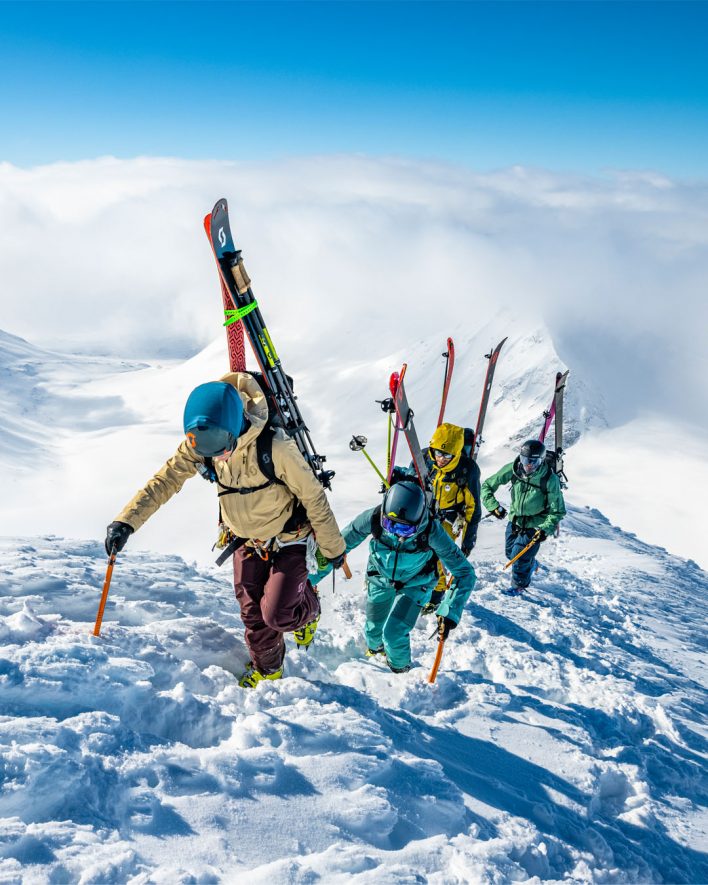
Over the next few days, as we followed a frozen river valley snaking its way into the heart of Sarek, the inspiring lines surrounding us had me dreaming of future trips to ski some of the hidden peaks. Headphones and an old workout playlist made pulling my sled easier, and my body adapted to the movement. It became almost enjoyable. I would still classify the endless traversing sections as mostly Type Two fun, but in the same way I loved road bike racing in college, the rhythm was an easy adjustment that required a meditation. I focused on my music and the landscape, and the miles glided by.
At our next break I noticed Jackie was the only one without headphones. “Do you have some music or podcasts?” I asked.
“I didn’t bring any headphones,” she replied.
“I have an extra pair if you’d like to borrow them. You’ll see, it makes this part so much more enjoyable.” I started to open my duffel bag to search for them, when she said spiritlessly, “No thanks, I’d rather stay in suffering mode.”
I hadn’t seen her truly smile in over a week. I knew she was still beating herself up about day two, but I didn’t know how to help her escape what appeared to be an inner gloom. I kept telling her not to worry about it, that we all have bad days, but my words had no impact.
On certain days timing and pacing aren’t particularly important, but often in the mountains, they can be essential to safely traveling through hazards or arriving at camp before dark. We had set goals of camp locations in the planning phases of the trip, calculating food and fuel accordingly. Our team started frustratedly telling Benj and I that we were moving too quickly, but we were simply trying to keep a steady pace to keep us on track with our movement days and, therefore, our supplies. There were many missed moments during the expedition where we could have all communicated and reevaluated our goals. Still in the early days, I maintained hope that our original mission was still in line for our team with some extra effort from Benj and I, and that the tensions would ease with our collective successes.
Late in the afternoon on day five, Benj looked at his watch as he turned to me and said, “We aren’t going to make it to the cabin before dark at this pace.” We were trying to reach a small wind shelter for our next camp, to be stationed there for a few days to try and ski the next four peaks. “If you can break trail for the rest, I think I can pull Jackie’s sled for her,” Benj offered as a solution to speed up the team. A cold storm moving in motivated us to reach camp, where we could stay for several nights. Rest was a rarity on this expedition, and the more efficient we could be with time, the more moments we would have to recover. As the fatigue grew deeper in everyone, this became even more vital.
When Jackie arrived, Benj proposed his idea to take her sled and she reluctantly agreed. We approached Mikkastugan, our wind shelter for the next few days, under pink and orange clouds whisking on the setting sun, grateful to have a small cabin to cook in as the bitter cold settled in.
After a well-deserved rest day in an icy storm, we had a relatively easy summit number three on Sarektjåkkå’s main summit, Stortoppen. Then we saw the rocky ridge between this summit and the next peak, Sarektjåkkå’s north peak, Nordtoppen. That narrow ridge, covered in frozen, vertical, wind-sculpted snow formations, posed a very technical pathway to the next summit. We knew it was going to be alpine climbing. After some discussion, we left our skis and made our way to Nordtoppen, with Benj and I now in full guiding mode, lowering and managing everyone else through rappels, and then roping the group through the exposed harder sections on the ridge. After a quick touch of summit number four, the challenging return of the ridge still lay ahead.
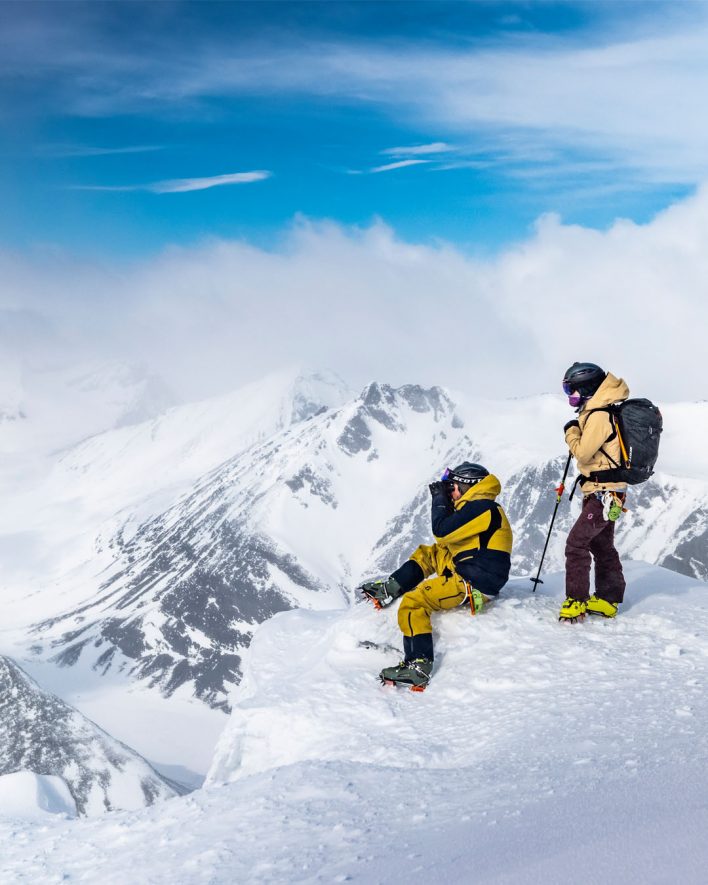
For the first climbing section of the ridge heading back, Benj went up to the top to haul the team from above while I helped set them up from below. After verifying that Jackie was tied in, I turned around to help Martin, when, all of a sudden, I heard Benj shouting in alarm from above. I looked up and immediately saw what he was upset about. After getting attached to the rope, Jackie had somehow turned the rope behind herself while putting on her backpack. She couldn’t get her pack off to untangle herself with her ice axes in hand. I solo climbed up to her and took off her pack and untangled her rope.
“I’m so sorry,” she kept saying.
“It’s all good, no worries,” I said to comfort her. I was trying to balance giving our partners responsibility for themselves while managing the terrain and technical components. But they were out of their element and making mistakes that couldn’t happen in such consequential terrain. I never doubted Jackie and Reine’s incredible athleticism or their world-class skills in descending any ski line of their choosing, nor Martin’s own good level of physical conditioning and fine talents as cinematographer; but safely climbing the rock, ice and exposed alpine ridges that we were forced on due to the high avalanche risk, as well as the timing of mountain travel and the navigation and pace setting through wilderness terrain, are different matters altogether. Benj and I needed, it seemed, to be guides to get us through this project and home safely.
As we approached the final technical climbing obstacle of the ridge, a wall of dark gray appeared on the horizon to our right. The evening’s forecasted storm was arriving early. By the time Benj was halfway up the pitch, the squall was fully upon us with violently gusting winds and the air temperature dropping deeply below freezing. I was in the unprotected, shady notch for over an hour, getting the three members of the team safely tied into the rope and up the overhanging wall as Benj hauled them from above. By the time it was my turn to climb, I could feel my body temperature dropping. As I was rapidly detangling one of the ropes that had been tossed around by the wind, Benj began shouting from above. His words were lost in the powerful wind hissing on the hood of my jacket. I later discovered that he was frightened that I was becoming hypothermic. I tied myself into the now-untangled line and ran up to the protected nook of the ridge where the team was waiting. Benj embraced me in his arms to warm my frozen core as I took a minute to breathe out of the ripping wind. “Let’s get the hell out of here!” I hollered as I jumped up and walked over to my cached skis on the storming summit ridge.
Being able to communicate with your mountain partners is extremely important in traveling safely as a team. However, by this point in the expedition, the general fatigue and isolation in three separate tents was making us all drift into quietness. We tried to debrief with the team about the close calls on the ridge, but between utter silence and brief responses, Benj and I didn’t know if they understood that our second summit that day had been too close for comfort. When we lose our margin of error, we begin to push the balance closer to the edge and safety can be compromised. The mountains can be very unforgiving in those moments.
Benj had been growing frustrated because he felt unheard and sensed that the others were taking offense to safety advice. After the close calls and failed debriefs, any remaining team spirit in him was broken. He retreated into his head and spoke mostly French just to me, adding to the group detachment. He felt we were alone in the decision-making and that we needed to step up as mountain guides if we were going to safely succeed in the Arctic 12 goal. Because of our careers, we had an added pressure: If an accident happened, we could legally be responsible for the team and the decisions made, even as unpaid guides.
A few days after leaving our little shelter, we continued pulling our supplies into the wilderness toward our next summit, Áhkká. Goggles on, buff covering my face, hood zipped, I was getting used to pushing my face into the bitter Arctic storms now while pulling my sled. In hopes of increasing group unity, Benj and I were trying to continuously set a mellow, steady pace. This rhythm gave me time to enjoy the subtle movements of the snowy, barren landscape the wind was sculpting. Suddenly to our right, a family of five reindeer appeared in the white. They raised their heads and stood perfectly still watching us slowly approach before carefully moving a leg at a time. In natural synchronization they trotted and then, in less than a moment, galloped to escape us intruders. As they ran into the frigid, windy hills, their majestic dark bodies slowly disappeared into the gray white of the blowing snow, and, in a pure moment of joy, I was reminded what utter serenity felt like.
As the days and summits were checked off, our group grew even more distant. We moved out of the Sarek wilderness and into the more visited parts of Sweden’s mountains of the Kebnekaise range. We walked slowly most days, just fast enough to finish our project with our allotted food and fuel. The expedition became a meditation of isolation in the mountains, as my life partner became frustrated beyond words, and my friend Jackie remained quiet and seemed locked in a deep melancholy that she didn’t want to talk about. Unfortunately, there was no spare time to really get to know the other two teammates. I was incredibly sad that not everyone seemed able to enjoy the journey. I tried to maintain belief that eventually the veil of hardship would lift, and we would come together as a team traveling together throughout these tempestuous yet exquisite landscapes.
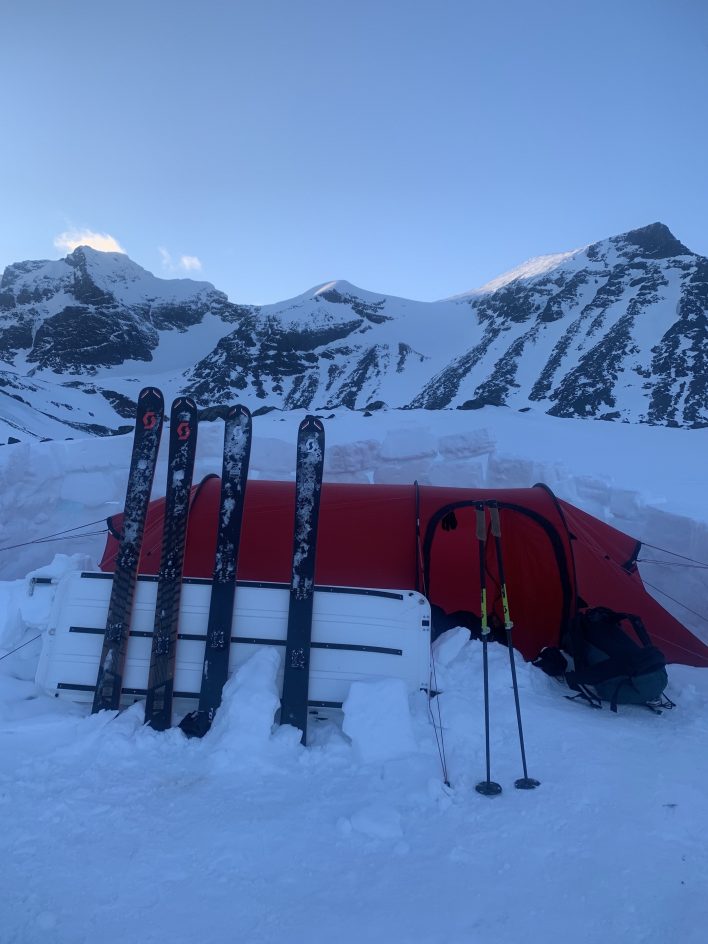
On the final ridge climbing up toward Áhkká’s Stortoppen, Benj asked the team to put their crampons on before traversing an exposed section, to only hear opposition that crampons were not needed. Deep in the mountains where rescue was not guaranteed and the closest road was almost always more than a day’s walk, even a broken ankle could be serious. While trying to minimize our margin for error as a team, we were left feeling disrespected when we received pushback in critical moments on technical terrain. Other team members felt similarly slighted, taking the mountain advice as attacks on their abilities. In every way possible, we were speaking different languages.
Tensions continued to build on top of normal expedition weariness, in part because Benj and I were looked at to guide the technical climbing days, make the plan, break trail, navigate, set the pace and create options to navigate the many obstacles we faced, yet others in the team seemed to decide when they did or didn’t want to be guided. This back and forth of their desired roles was never communicated, producing unattainable wishes. We would’ve loved to have teammates in the decision making and moving through the mountains, as that’s how we had imagined the trip would be. But advancement had to be made, and safely, so we continued to guide the group.
Day 25 and summit number 12, Šielmmáčohkka, was the culmination of the trip, but not in any way I could have imagined when leaving on day one. Like for so much of the traverse, a storm appeared to be moving in sooner than was forecasted. The clouds began to lower, the wind pulsed to a rip and our visibility decreased. I spaced out the team to make sure no more than one person at a time was exposed to the final slope that we needed to cross.
Watching Benj head into the white on the summiting slope where avalanche hazards lurked, I turned back to make sure the rest of the team was in a safe spot. To my surprise, I saw a team member looking down at their cellphone on social media instead of paying attention to their teammate on the exposed slope. I was at a loss for words, heartbroken that we couldn’t come together even for the last summit. Even the most incredible ski turns off a perfect summit like surfing a glassy wave were left flat as we descended from that final summit all the way down to the cabin.
Our last day prescribed one last challenge: exiting 17 and a half milesfrom the wilderness, Nikkaluokta, through a rapidly melting valley. In what could’ve been a comedy sketch with how bad the conditions were, Mother Nature gave us one last blockade to navigate. With long stretches of dry ground and opening rivers and thin ice, it seemed like we were going to have to carry the sleds on our backs, perhaps over several days. There were moments when moving 15 feet took 30 minutes.
When we passed an old abandoned wooden cabin, I stopped and unclipped my sled to explore this surprise. Inside was a tiny room with a fireplace, a wooden table and a cot laid down by time. A small shelf was filled with old books, newspapers and untold memories. My eyes glistened. I cherished how we were given one more hidden gem in this last desperate moment of the trip, and my smile returned.
The conditions miraculously improved shortly after the cabin visit. The valley widened and the water became shallower. The streaming river turned to a frozen path we could safely walk on. What could’ve been days quickly turned into hours. Before we knew it, we made it to the parking lot. After 26 days, 258 miles, and 45,111 feet of climbing, we’d climbed the 12 highest summits in the Swedish Arctic, skiing nine.
Hearing my friend, post-expedition, say on camera that she had no highlights from the month we spent in the mountains was beyond sorrowful. I fully agreed that it was an extremely challenging expedition mentally. However, it was difficult to hear how she, even after the smoothing of time passed, couldn’t see past the hardships to find any pride or joy in the accomplishment or journey. I wish that standing under one of the many couloirs I saw heading into Sarek during the first week, that I had spoken up and proposed pivoting to an entirely different trip. If we had just taken the time to reassess our goals given the conditions and the group, I think we all would’ve had more fun and fulfillment just wandering throughout Europe’s last wilderness while skiing lines that inspired us.
There would have been less technical climbing days and fewer miles, making the group more balanced, and we would’ve been able to ski and film more, which is I think what the others had imagined the trip would be. Failure of the Arctic 12’s original ambition would have provided more success in the mountains and as a group. But as five determined minds with a defined target, and with unfortunate communication gaps, we instead continued, succeeding in the mission but failing as a group.
The differences of mountain backgrounds and desires created human tensions far greater than the constant force of the Arctic winds on our faces. In the end though, these challenges teach us about ourselves, and all we are left with are the lessons and our memories. So despite the human hardships, I will remember the beauty of mountain solitude and the Arctic colors of the horizon haloing the vast landscapes, several ski descents down perfect (and far less than perfect) snow with both gleaming sunshine and storming clouds, moments laughing in the tent with Benj under an overhanging saucisson and listening to Toto, and most of all the family of reindeer staring back at me in the storm and then disappearing into the white blowing haze of the barren, serene hills of Sweden’s Arctic.
Erin Smart is an IMFGA accredited guide who lives in La Grave, France. She has guided around the world and written for Backcountry, Alpinist and Powder Online.










Interesting to read other point of view than Jackie’s.
Can feel this expedition has been stressfull for you and Benj trying to assess conditions dealing with hazardous snowpack and technical terrain. Looks like you had the right call as everybody came back home safely!
Long live La Grave!
“Each to her/his own” is not always preffered but like a wave pushed on you.
Its how the debief more mentally sets in each individual that counts.
Long live La Grave!
What is the brand and model of sleds that are pulled in this article?
We used Jemtlander sleds and they worked great!
https://jemtlander.se/